Nvidia’s Deep Learning Super Sampling (DLSS) has been an undeniable selling point for RTX GPUs since its launch, and AMD’s attempts to fight back haven’t exactly been home runs.
But what if FidelityFX Super Resolution (FSR) could grant the huge performance gains of DLSS without all the restrictions imposed by Nvidia? If that sounds too good to be true, I wouldn’t blame you. After all, Nvidia’s special sauce of machine learning wasn’t supposed to be easily replicated.
Well, hold on to your hat because a modder recently discovered how easily FSR could ape off DLSS. And after trying out the solution myself, it’s made me more excited about the potential for FSR than ever.
What we have now
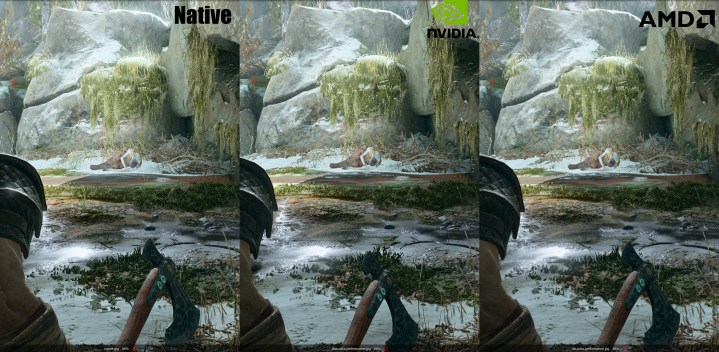
Before we get to the mod itself, it’s worth setting the stage for how we got here. FSR was AMD’s first attempt at a DLSS killer, and unfortunately, it left a bad taste in our mouths. Despite the rapid adoption in the first generation of FSR 1.0, the performance and image quality just didn’t cut it.
All that changed with the release of the technology’s second generation. I’ve tested FSR 2.0 in its launch title, Deathloop, and the results are clear: DLSS provides a slightly higher performance boost, but FSR 2.0 is almost identical in terms of image quality. Based on Deathloop, you should use DLSS if you can, but FSR 2.0 is a very close second if you don’t have a supported GPU.
My expectations were surpassed further when I tested God of War, seeing the margin with DLSS shrink even more. In fact, FSR 2.0 was actually around 4% faster than DLSS with the Ultra Performance preset. You’re not trading much of anything with image quality, either. Even at the intense Ultra Performance preset, it’s nearly impossible to spot any differences between FSR 2.0 and DLSS while playing.
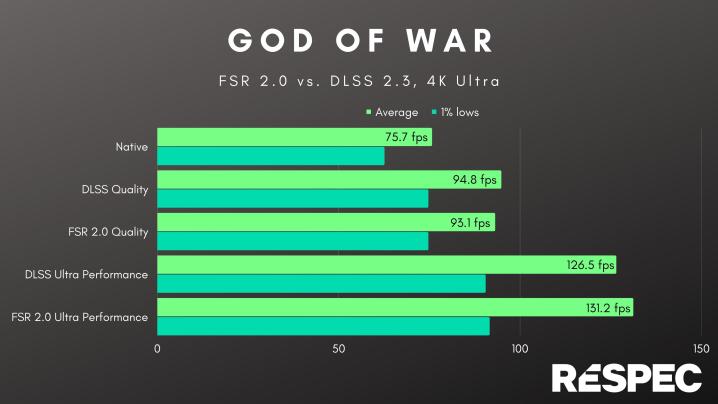
This is the real deal. The only problem? FSR 2.0 is available technically, but it’s not seeing the rapid adoption that the first version did. It’s available in only four games now: Deathloop, Farming Simulator 22, God of War, and Tiny Tina’s Wonderlands. The upcoming list isn’t all that exciting, either, headlined by Hitman 3, Eve Online, and the recently delayed Forspoken.
Hence, the need for a seemingly impossible solution that takes the goodness of FSR 2.0 and widely expands its effect to as many titles as possible. And that’s where the fun begins.
A look into the future

About a month ago, modder PotatoOfDoom released an FSR 2.0 “hack” for Cyberpunk 2077. What the modder realized was that DLSS and FSR 2.0 require basically the same information — motion vectors, color values, and the depth buffer. That allowed PotatoOfDoom to create a simple instruction translation, using the DLSS backbone to send FSR 2.0 instructions. It’s like how Wine works for Windows games on Linux, according to the modder.
I’ll circle back to what these similarities between DLSS and FSR 2.0 mean, but let’s get games out of the way first. I followed the instructions and was able to implement the mod in Cyberpunk 2077, Dying Light 2, and Doom Eternal — all games that don’t currently support FSR 2.0. Doom Eternal was the only game that struggled with the mod, blocking out the DLSS option in the settings menu entirely. That was a no-go.
But Cyberpunk 2077 and Dying Light 2 were an absolute treat. The mod isn’t quite as powerful as a native implementation, but it’s still very close. The difference is less than 10% at most, even with all of the settings cranked up at 4K (including the highest ray tracing options).
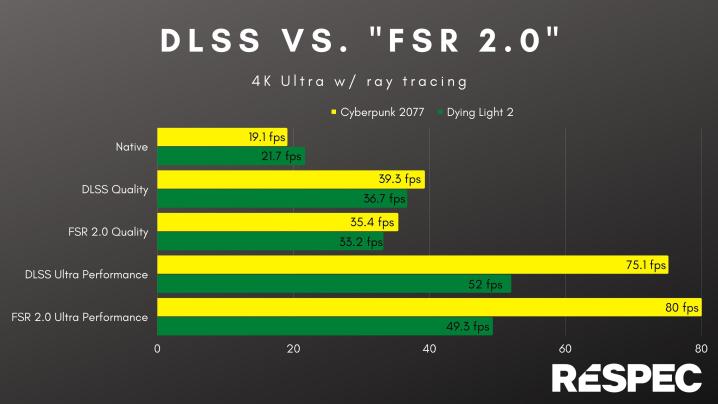
Image quality was just as good, even on this self-described hack. In a still image, Dying Light 2 actually looked slightly better with FSR 2.0, and it was nearly identical in Cyberpunk 2077. The main difference, as was the case in God of War and Deathloop, is that FSR 2.0 doesn’t handle distant fine detail as well. You can see that on the phone lines in Cyberpunk 2077 below. It’s damn close, though.
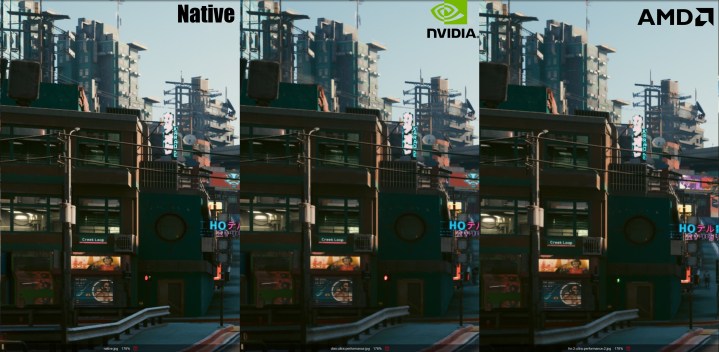
DLSS and FSR 2.0 look largely the same with a still image, but it’s the motion that matters. I saw heavy ghosting in Dying Light 2 that wasn’t present with DLSS or FSR 1.0, and flat textures cause some issues with masking.
Certain elements, like the smog from the sewer in the Cyberpunk 2077 screenshot below, don’t include motion vectors. FSR 2.0 and DLSS get around the issue with masking the element (like in Photoshop) so it’s not included in the supersampling. Unfortunately, they go about the masking in different ways, leading to the nasty pixelation with the FSR 2.0 hack that you can see below.
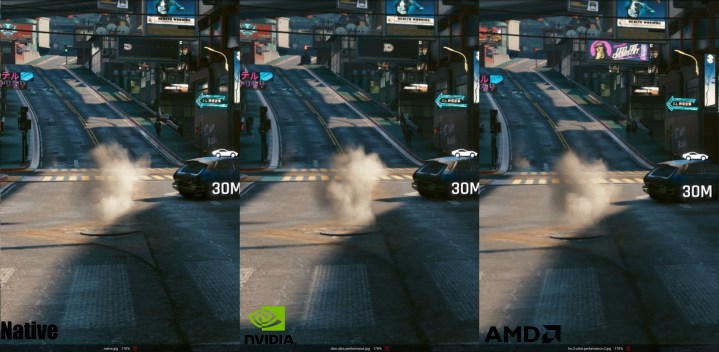
Even with those issues, it’s remarkable how close DLSS and FSR 2.0 are, both on a gameplay and a technical level. PotatoOfDoom summed up how much they share in an interview with Eurogamer: “I expected to work on [adding FSR 2.0] for several days, but was pleasantly surprised that it only took me a few hours to integrate.”
The point isn’t that you should necessarily go out and use this mod to add FSR 2.0 to every game. Rather, this mod reveals the deep similarities between DLSS and FSR 2.0 — something Nvidia might not want to readily admit.
Taking deep learning out of supersampling
DLSS is all about machine learning; it’s right there in the name. And to this point, Nvidia has insisted for years that DLSS only works on its most recent graphics cards because they provide the AI cores necessary to perform the supersampling. That’s true, but FSR 2.0 is proof that the advantage provided by AI is small and, for the most part, unnecessary.
A big reason why Nvidia’s GPUs sell above list price is DLSS, even if it doesn’t need to be.
There are a lot of similarities between DLSS and FSR 2.0, even concerning Nvidia’s machine learning bit. DLSS is using a neural network and FSR 2.0 is using an algorithm, but both are fed with the same inputs and use the same overall system to render the final output. The fact that PotatoOfDoom was able to develop one mod that works across several DLSS titles in a few hours is a testament to that.
The main issue now isn’t that DLSS is bad — it’s excellent, and you should use it if you can — but that the feature is exclusive to only a few expensive graphics cards. Even when GPU prices are falling, Nvidia’s low-end and midrange models continue to sell for above list price. And a big reason why is DLSS, even if it doesn’t need to be.
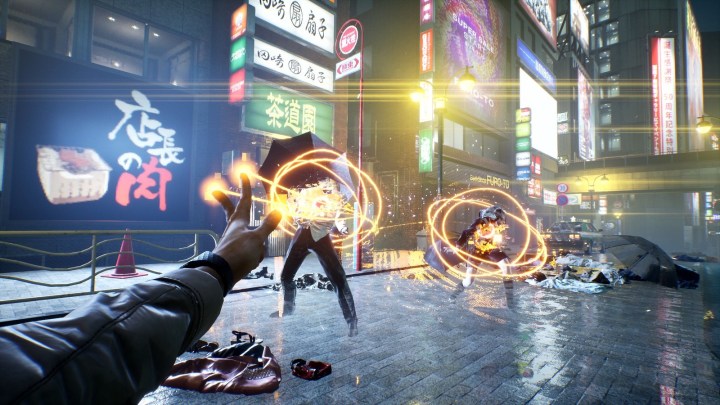
General-purpose solutions like FSR 2.0 and Unreal Engine’s TSR (temporal super resolution) are the way of the future. They work with basically all modern hardware, and developers consistently insist that they only take a few hours to get working.
DLSS doesn’t need to go away, but it would be nice to see Nvidia leverage its relationships with developers to get a general-purpose supersampling feature into games that support DLSS already. And no, Nvidia Image Sharping, which is basically FSR 1.0, doesn’t count.
Catching up
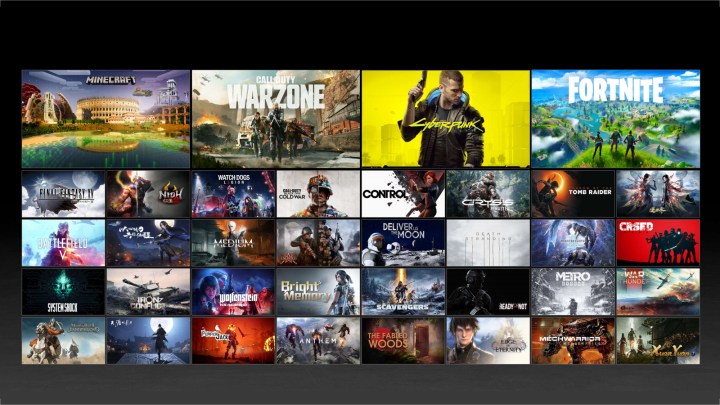
FSR 2.0 is genuinely impressive, but game support is holding it back. Far more games support DLSS than even FSR 1.0, and the official list of four FSR 2.0 is embarrassing. I’m not excited for too many of the upcoming FSR 2.0 titles, either, with the list mostly comprised of older or smaller games.
PotatoOfDoom’s mod is a hopeful sign, but we need more FSR 2.0 games for it to even stand a chance against DLSS. It might be tempting to root for AMD here, but it’s important to remember that DLSS still has a minor lead and is supported in far more games. AMD has a lot of ground to cover, and FSR 2.0 isn’t being added into games at nearly the rate that FSR 1.0 was.
Still, it will be interesting to see how the dynamic between DLSS and FSR 2.0 adjusts over the rest of the year. AMD just released the FSR 2.0 source code in June, after all. For now, DLSS is still the way to go for its game support and slightly better image quality, but it’s not a selling point on an Nvidia GPU like it once was.
This article is part of ReSpec – an ongoing biweekly column that includes discussions, advice, and in-depth reporting on the tech behind PC gaming.
Editors’ Recommendations




